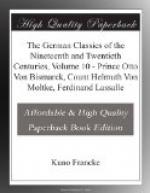Then the chulos entered—on foot, with gay hangings draped over their right arms. They were followed by six picadores on horseback, dressed in leather jerkins and breeches, protected on the right side with bands of iron. They wore Spanish hats and carried each a heavy spear on which there was an iron point only half an inch long. Their saddles were of the high cowboy type, and they sat their horses well. Under the accompaniment of deafening applause the matador (literally, the murderer) took his place at their head. His name was Cuchiera, and he was a famous and celebrated hero of the arena. Thus this phalanx advanced toward the royal box, where Queen Christine, wife of Munoz, Duke of Rianzares, was seated, and dropped to their knees to offer her the royal salute; whereupon twelve thousand people hissed.
At last the chief actor entered, a powerful black bull with sharp horns and fiercely glistening eyes. He had been in a room with holes in the ceiling through which he had been poked with pointed sticks. He was, therefore, tolerably ill-humored before he entered the arena. As soon as the doors of his prison were opened he shot forward to the centre of the field, looked fiercely about him, greatly astonished, pawed the sand with his feet, and then hurled himself upon the nearest picador. This man held his ground, and permitted the maddened bull to rush against his pointed spear. The horse had his right eye bandaged lest he see the bull and bolt. The attack, however, was so fierce, and the rider so firmly seated in his saddle, that both he and his horse were lifted up and thrown over backwards. At the same moment the sharp horns of the bull were fastened in the horse’s belly. A stream of blood, thick as your finger, spurted out directly from the horse’s heart. The picador was lying under his charger, and was prevented by his costume from freeing himself. His certain end was at hand if the chulos had not come to his assistance with their gay draperies. The bull immediately let go his prey and hurled himself upon the men on foot, or rather upon their gaudy cloaks. He chased one the entire length of the arena and, when his foe had escaped him by jumping the barrier, he made the stout fence tremble under his hammering horns. At the disappearance of his enemy the bull stood stock still, as if dumfounded, until a second picador met his glance. This horseman had the same experience as his predecessor, but before the chulos could bring help the bull buried his horns a second time in the belly of the convulsed horse and carried it high up in the air through half the length of the arena. The third horse was ripped open in a trice. The wretched animal actually caught his feet in his own entrails and dragged them from his body bit by bit. In this condition he was beaten and given the spurs and was forced to await a second attack by the infuriated bull.




